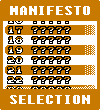 a review of Secret of Evermore
a review of Secret of Evermore
a videogame developed by square usa
and published by squaresoft
for the super nintendo entertainment system
text by Ario Barzan
Ask me about RPG’s, and I’ll admit to once having a thing for them: an affinity that drove me to emulate Tales of Phantasia on a stuttering computer and max out the timer on Final Fantasy VII. Ask me to tell you what the “thing†was, and…I can’t, exactly. I’d like to think the unmentionable was a phase, that the games were an outlet for nervous ticks at an unstable period. Now, the phrase “random battle†will get a rolling of eyes, a sigh, maybe a bar of soap in your mouth.
Final Fantasy XII has recently been called a Beacon of Nobility. I’m sorry, though: it was only a step forward on the long staircase RPG’s need to climb to escape from their stone-age. See, back in 1995, Secret of Evermore was doing what should be done now. It was, presumably, Square USA’s answer to Secret of Mana, and it got damn near everything right.
Select a new file, and you’ll find those first moments slightly…off. The setting: dingy Podunk – a nameless name. Trash rolls about on the street, a couple youths play marbles, and a boy and dog emerge out of a theater showing “The Lost Adventures of Vexx.†It’s humble, and clunky. In no time at all, a cat grabs the canine’s attention, and he sprints away in the pursuit of happiness. As the boy follows, the chase leads to an old mansion, setting in motion Very Unusual Things. Once inside, bumbling curiosity activates a mechanism – a transporter that shifts the kid and his pet over to another dimension. This dimension is Evermore, a combination of personal Utopias. Utopias of whom? Why, the scientific minds behind the project.
Charming as this concept is, if you go invest in RPG’s for their plots, you are not going to be thrilled with Evermore. If, on the other hand, you are like me, and realize that most “fabulous†video game plots are poor summer movies, and prefer to revel in what the medium is better at doing now, then you’re in luck. The plot is there to dictate advancements in setting, but it is by no means a backbone. Sparse and never-too-serious events take the boy to different locales, each representing historical periods. Prehistoria segues into Antiqua, then Gothica, and, finally, Omnitopia.
Let’s throw the trash-bag out. In what seems to be a common cold of video games, Evermore’s conclusive chunk is weak: an obtuse splurge of glass tubes and pristine interiors. The rest is picked at the peak of freshness, so what happened? Omnitopia is, however, small, and not a flow murderer. Also, the dialogue. But, no, at the same time, it’s not bad, really. Just funny, in the way that it would be funny to see a figure skateboarding in a Friedrich painting. The stuff’s saved by being brief and reasonably pleasant.
Onto the good. On the chance one has played Mana, they’re already acquainted with part of Evermore’s system. Everything is presented from a lightly lopsided bird’s-eye view. Press Y to bring up a ring menu (very slick), and hold A when the percentage display on the bottom, representing stamina, allows you to dash. The boy’s dog acts as a secondary character whose aggressiveness can be toggled on an A.I. scale.
As the boy progresses through trials or passive events, he is rewarded with, or given, weapons, be it a bazooka, sword, or…bone. Use that weapon enough, and it will deal more damage. After a certain point, you can hold down the attack button to charge your attack. Effects vary – if you’re wielding a spear, it launches across the screen for long-range damage.
Not to worry. Combat supports improving statistics’ hardiness. It is actualized, seamless – no swirling vortexes, chess board positioning, or victory animations here, folks. And, hell, it’s well done. What a blessing. Dragon Quest VIII was lovely, lovely enough to make R2 my MVP button, but that didn’t stop its NES mechanics from plunging the package into flames of torment. Here’s the thing. DQVIII, and the bulk of RPG’s, are the British army, and Secret of Evermore is the feisty American force that runs around, hides in trees, and doesn’t stand for the horsestuff of lining up and trading blows.
There’s a compact, brisk intelligence to fighting. Unravel your rival’s capabilities, and when the choice moment comes, line up and strike the bastard, resulting with the sound of hitting a table with one’s knuckles. This is not as easy as it sounds. Many enemies are faster, or, if they are slower, unexpectedly lunge out with territorial ferocity, making well-played victories against them an “A†on the proverbial paper. Bosses do not forsake their title. You’ll go from fighting a crab-like arachnid in the skull of a dead behemoth, to a gladiator in a Colosseum, to a freak-show-gone-loose (think Bigfoot, but ten times bigger…and only his head is visible) accompanied by possessed puppets on a stage.
Rather than spells being introduced by leveling up, they’re taught to you by a people. And in place of magic points are raw materials, which can be combined to specific effects. It’s guaranteed that you’ll miss out on the bulk of these spells the first time through, and even the second. Evermore is crawling with so many secret locations that it’s kind of mind-boggling. It’s also rich with said materials. Try nudging suspicious crannies: they will often yield something.

Most important of all is this: A lush wonder surrounds the journey. You need to give Evermore a little time. It doesn’t have an immediate sparkle. Where its inspiration is truly outdone is in the ripeness of emotion.
You can feel this in the visuals’ layers: sights give the impression of a mystery beyond what’s in front. This is a bit of a wonder, considering Western games’ ugly art history that continues to perpetuate itself (the best recent, popular example is Oblivion – an attractive, albeit generic, world with character models that look like the team modeled and mirror-imaged hecking middle-aged cosplayers). There’s the amazing, gravitational soundtrack by Jeremy Soule – his first project in the medium, and still his best. And it’s not only in the music – it’s in the lack of music. Evermore’s world is not afraid of quietness. There are forests, ecosystems, whose leaves rustle as animals chirp and hoot, and vast, windy expanses with grumbling pits.
Here is also why the game succeeds: structure. FFXII improved combat’s flow by removing a number of unnecessary abstractions, though hell if its containers for the combat weren’t blunt. By contrast, Evermore’s dungeons are curious, nuanced complexes testing not only your offensive skills, but your navigational and puzzle-solving abilities. In them, a hint of surreal Metroid design emerges, as well. Get inquisitive or lucky enough, and you might walk past a wall and through an unseeable maze to appear in a secluded chamber. Maybe there will be a person who can teach you a spell, or maybe a series of pots will await their opening.
 Honest-to-God life was invested into towns and villages. Nobilia, Antiqua’s capital, is a flood of happenings – chickens being fed by children, an old man preaching apocalyptic messages, people in their trading booths waiting for customers (keep track of the bartering system for great deals!); there is no other Super Nintendo site that matches this level of inhabitance.
Honest-to-God life was invested into towns and villages. Nobilia, Antiqua’s capital, is a flood of happenings – chickens being fed by children, an old man preaching apocalyptic messages, people in their trading booths waiting for customers (keep track of the bartering system for great deals!); there is no other Super Nintendo site that matches this level of inhabitance.
When I was a kid (I can hear the groans. Hush), one of my favorite things was to be outside for hours, lifting up rocks, logs, whatever, to see the life underneath. Evermore is those rocks, those logs. If you want to poke around, it lets you, and rewards you with impeccable atmosphere and sublime, little game-y elements. You’re thrown into the thick of things, and there’s a whole world out there, one that trusts the competence of the player behind the controller. Its craft holds up because it’s not bound by flimsy tech demos or self-absorption; it is universally, wonderfully made. Go out, get a copy, make a cup of tea, and settle down for a slice of joy.
–Ario Barzan
Pingback: THE ACTION BUTTON DOT NET MANIFESTO: A LIST OF THE THIRTY-THREE BEST GAMES OF ALL-TIME | action button dot net